Introduction
China, a country with a history spanning over 5,000 years, is a treasure trove of ancient wonders, cultural landmarks, and historical sites that tell the story of one of the world’s oldest continuous civilizations. From the Great Wall that winds its way across mountains and deserts, to the imperial palaces and bustling ancient cities, China’s historical sites offer a glimpse into its rich and varied past.
Historical tours in China are more than just visits to ancient structures; they are immersive experiences that bring history to life, allowing travelers to walk in the footsteps of emperors, warriors, philosophers, and ordinary people who shaped the nation’s history. These tours offer unique insights into China’s dynastic changes, cultural evolution, architectural achievements, and the philosophies that have guided its development.
Whether exploring the grandeur of Beijing’s Forbidden City, marveling at the intricate carvings of the Longmen Grottoes, or standing in awe before the Terracotta Army in Xi’an, visitors are taken on a journey through time. Each destination reveals a different chapter of China’s story, from the ancient dynasties that built the foundations of Chinese culture to the more recent historical events that have shaped modern China.
China’s historical tours also provide an opportunity to understand the country’s cultural heritage and traditions. Visitors can experience local customs, participate in traditional ceremonies, and learn about the philosophies of Confucianism, Buddhism, and Daoism that have profoundly influenced Chinese society.
In summary, historical tours in China offer a captivating and educational experience, connecting travelers with the rich tapestry of China’s past and providing a deeper appreciation of its present. Through these tours, one can gain a comprehensive understanding of the cultural and historical forces that have shaped one of the world’s most fascinating civilizations.
Overview of Historical Tours in China and Cultural Heritage
China boasts a history that stretches back over five millennia, making it one of the world’s oldest continuous civilizations. This long and storied past is marked by the rise and fall of numerous dynasties, each contributing to the rich tapestry of Chinese culture, philosophy, and innovation. From the ancient Shang and Zhou dynasties to the grandeur of the Tang and Ming, and the transformative Qing era, each period has left an indelible mark on the nation’s identity.
China’s cultural heritage is equally profound, encompassing a wide range of achievements in art, literature, science, and technology. The Chinese invented papermaking, printing, the compass, and gunpowder—innovations that have had a lasting impact on the world. In literature, classical works such as the “Book of Songs,” “Journey to the West,” and the poetry of Li Bai and Du Fu remain influential. Chinese philosophy, particularly Confucianism, Daoism, and Buddhism, has deeply shaped societal values and ways of thinking.
Architecturally, China is home to some of the most remarkable structures in human history. The Great Wall, the Forbidden City, and the Terracotta Army are just a few examples of the country’s impressive ancient constructions. Additionally, China’s diverse landscapes, from the lush rice terraces of the south to the deserts of the northwest, have influenced its regional cultures and lifestyles.
Traditional Chinese arts such as calligraphy, painting, music, and dance, as well as folk traditions like tea ceremonies, martial arts, and festivals, further illustrate the depth and breadth of China’s cultural heritage. These elements combined reflect a civilization that values harmony, balance, and respect for nature and ancestors.
Importance of Historical Tours in Understanding Chinese Civilization
Historical tours are vital for gaining a comprehensive understanding of Chinese civilization. They offer immersive, on-the-ground experiences that go beyond what can be learned from books or lectures. By visiting historical sites and engaging with local cultures, travelers can see firsthand the artifacts, architecture, and cultural practices that have shaped China’s development over millennia.
These tours provide context and clarity to China’s historical narratives. Standing atop the Great Wall, one can grasp the immense effort and strategic importance of this monumental structure. Visiting the Forbidden City allows one to imagine the lives of emperors and courtiers who once walked its halls. Exploring the ancient city of Xi’an and its Terracotta Army provides insight into the might and reach of the Qin Dynasty and its first emperor, Qin Shi Huang.
Furthermore, historical tours help to appreciate the evolution of Chinese art, technology, and philosophy. Observing the intricate designs of classical gardens in Suzhou or the religious significance of the Longmen Grottoes deepens one’s appreciation for the artistic and spiritual achievements of past dynasties. Engaging with local traditions, such as participating in a tea ceremony in Hangzhou or watching a kung fu demonstration at the Shaolin Temple, enriches understanding of the living cultural practices that have been handed down through generations.
In essence, historical tours are not just about seeing ancient sites; they are about experiencing the legacy of China’s rich history in a tangible way. These tours foster a greater appreciation and respect for the complexities and contributions of Chinese civilization, bridging the gap between past and present. By immersing oneself in China’s historical and cultural heritage, one gains a deeper, more nuanced perspective of this vast and influential nation.
Major Historical Destinations
The Great Wall of China
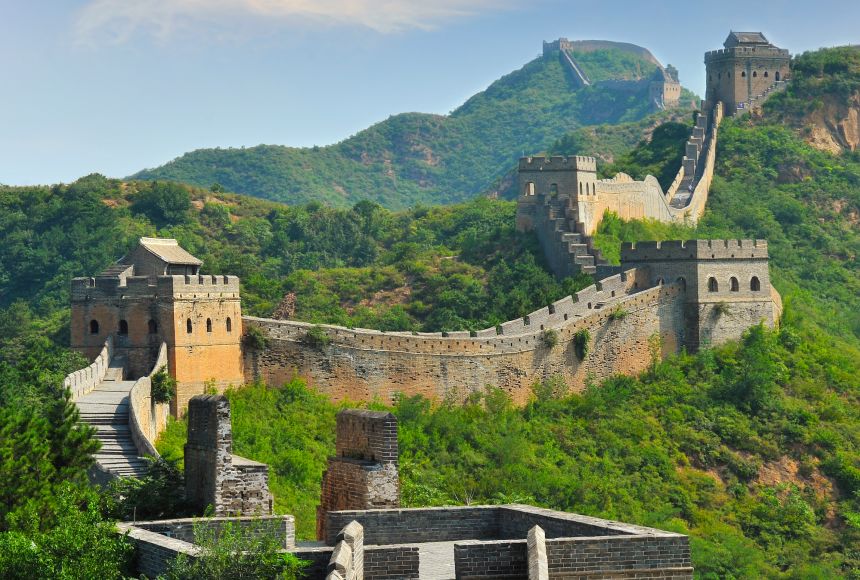
Description and Significance
The Great Wall of China stands as one of the most iconic and enduring symbols of China’s historical grandeur and engineering prowess. Stretching over 13,000 miles from the Bohai Sea in the east to the Gobi Desert in the west, this colossal structure was built over several dynasties, with the most well-known sections constructed during the Ming Dynasty (1368-1644). The wall served multiple purposes: it was a formidable defensive barrier against invasions by nomadic tribes from the north, a means of border control, and a way to project the might and organizational capabilities of the Chinese state.
The Great Wall is not a single, continuous wall but a series of walls and fortifications, including watchtowers, barracks, and signal towers. Its construction involved an immense amount of labor and resources, utilizing bricks, tamped earth, wood, and stone. The sheer scale and complexity of the wall reflect the ingenuity and determination of ancient Chinese society.
Key Sections to Visit
- Badaling
- Description: The most visited and well-preserved section of the Great Wall, located near Beijing.
- Highlights: Wide, restored paths with watchtowers offering panoramic views of the surrounding mountains.
- Activities: Ideal for first-time visitors and those looking for a more accessible experience with amenities.
- Mutianyu
- Description: Known for its stunning scenery and less crowded pathways, Mutianyu is another well-preserved section.
- Highlights: Dense forests and restored watchtowers provide a picturesque setting.
- Activities: Popular for hiking, with options for cable car rides and a toboggan run for a unique descent.
- Jiankou
- Description: A rugged, wild section of the wall, famous for its steep and crumbling pathways.
- Highlights: Unrestored sections that showcase the wall’s original state and challenging hikes.
- Activities: Suitable for experienced hikers and adventurers seeking a more challenging and authentic experience.
- Simatai
- Description: A section known for its unique architectural features and night tours.
- Highlights: 15 watchtowers, varied construction styles, and breathtaking views of the Gubeikou Reservoir.
- Activities: Offers both day and night tours, providing a different perspective under the stars.
Activities
- Hiking: Exploring the different sections of the Great Wall on foot provides a deep appreciation of its scale and the surrounding natural beauty. Hikes can range from easy, paved paths to challenging, rugged trails.
- Photography: The Great Wall offers countless opportunities for stunning photographs, from panoramic vistas to detailed shots of ancient brickwork.
- Guided Tours: Engaging with a knowledgeable guide can enrich the experience, offering historical context, interesting anecdotes, and cultural insights.
- Cultural Experiences: Some sections, like Mutianyu, offer additional activities such as traditional performances and local food tasting, enhancing the overall visit.
Conclusion
The Great Wall of China is not just a relic of the past but a testament to human ingenuity, endurance, and the enduring spirit of the Chinese people. Visiting the Great Wall is an essential part of any historical tour in China, offering a profound connection to the country’s ancient history and a breathtaking adventure through one of the world’s most remarkable landmarks. Whether you choose the bustling paths of Badaling or the serene, wild trails of Jiankou, the Great Wall promises an unforgettable experience that brings the history of China to life.
Beijing Historical Tour
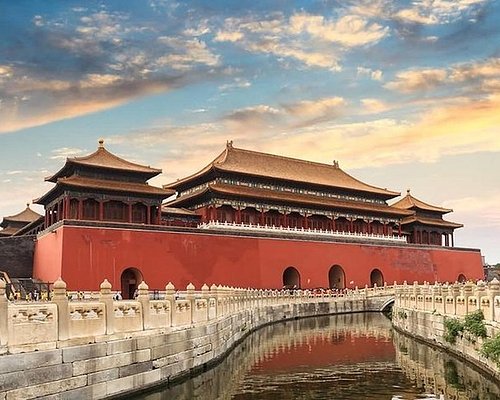
Beijing, the capital city of China, is a vibrant metropolis that seamlessly blends its rich historical heritage with modern advancements. As one of the country’s most historically significant cities, Beijing is home to numerous cultural landmarks, imperial sites, and architectural marvels that offer a window into China’s illustrious past. A historical tour of Beijing is a journey through time, revealing the grandeur and legacy of ancient Chinese civilization.
Key Sites
- The Forbidden City
- Description: The Forbidden City, also known as the Imperial Palace or the Palace Museum, is the largest and best-preserved ancient palace complex in the world. It served as the political and ceremonial center of Chinese emperors for nearly 500 years, from the Ming Dynasty (1368-1644) to the end of the Qing Dynasty (1644-1912).
- Highlights: Spanning 180 acres, it includes over 9,000 rooms, halls, and courtyards, featuring traditional Chinese palatial architecture, intricate woodwork, and valuable art collections.
- Activities: Visitors can explore the Hall of Supreme Harmony, the Hall of Preserving Harmony, and the Imperial Garden. Guided tours provide historical context and fascinating insights into the lives of the emperors and their courts.
- Temple of Heaven
- Description: The Temple of Heaven is a complex of religious buildings that was used by emperors of the Ming and Qing dynasties to perform annual ceremonies praying for good harvests. It is a masterpiece of architecture and landscape design, reflecting the relationship between heaven and earth in Chinese cosmology.
- Highlights: Key structures include the Hall of Prayer for Good Harvests, the Circular Mound Altar, and the Imperial Vault of Heaven.
- Activities: Visitors can walk through the tranquil gardens, observe locals practicing Tai Chi, and participate in guided tours that explain the site’s symbolic design and historical significance.
- Summer Palace
- Description: The Summer Palace, also known as Yiheyuan, is a sprawling ensemble of lakes, gardens, and palaces. It served as a summer retreat for emperors and is renowned for its natural beauty and harmonious blend of man-made structures with the landscape.
- Highlights: Major attractions include Kunming Lake, Longevity Hill, the Long Corridor, and the Marble Boat.
- Activities: Boating on Kunming Lake, strolling through the gardens, and exploring the richly decorated pavilions and temples provide a relaxing and culturally enriching experience.
Activities
- Guided Tours: Engaging with knowledgeable guides at each site can significantly enhance the experience by providing in-depth historical context, interesting anecdotes, and cultural insights.
- Historical Lectures: Many tours offer lectures by historians or experts who delve into the significance of each site and its role in Chinese history.
- Cultural Performances: Watching traditional performances, such as Peking opera or acrobatic shows, can add a dynamic element to the tour and offer a glimpse into China’s performing arts heritage.
Conclusion
A historical tour of Beijing is an immersive exploration of China’s imperial past and cultural achievements. The grandeur of the Forbidden City, the spiritual serenity of the Temple of Heaven, and the picturesque beauty of the Summer Palace collectively offer a comprehensive understanding of Beijing’s historical and cultural landscape. These iconic sites, combined with the city’s vibrant modernity, create a unique and unforgettable travel experience. Through guided tours, cultural activities, and personal exploration, visitors can connect with the rich history and enduring legacy of Beijing, gaining a deeper appreciation for one of the world’s most fascinating capitals.
Xi’an – The Ancient Capital
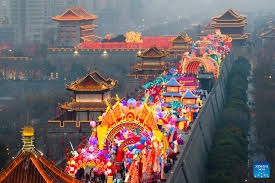
Xi’an, one of the oldest cities in China and the capital of Shaanxi Province, is a treasure trove of historical and cultural landmarks. Known as Chang’an in ancient times, Xi’an served as the capital for several of China’s most important dynasties, including the Zhou, Qin, Han, and Tang. As a pivotal starting point of the Silk Road, Xi’an was a melting pot of cultures, ideas, and innovations. A historical tour of Xi’an offers a profound insight into China’s ancient civilization and its contributions to the world.
Key Sites
- Terracotta Army
- Description: The Terracotta Army, also known as the Terracotta Warriors and Horses, is one of the most significant archaeological discoveries of the 20th century. Discovered in 1974, this vast army of life-sized clay soldiers was buried with Emperor Qin Shi Huang, the first Emperor of China, to protect him in the afterlife.
- Highlights: The site features thousands of intricately crafted soldiers, horses, and chariots, each with unique facial expressions and details.
- Activities: Visitors can explore the three main pits, view the impressive statues up close, and visit the on-site museum to learn about the history and significance of this UNESCO World Heritage Site.
- Ancient City Wall
- Description: Xi’an’s Ancient City Wall is one of the oldest and best-preserved city walls in China. Originally built during the Tang Dynasty and expanded during the Ming Dynasty, the wall encircles the city center and stretches approximately 13.7 kilometers (8.5 miles).
- Highlights: The wall is 12 meters (40 feet) tall and 15-18 meters (50-60 feet) wide, providing a panoramic view of the city from the top. It features numerous watchtowers, gates, and battlements.
- Activities: Visitors can walk or rent bicycles to traverse the wall, enjoying the historical architecture and scenic views. Guided tours often include detailed explanations of the wall’s construction and historical significance.
- Big Wild Goose Pagoda
- Description: The Big Wild Goose Pagoda is a Buddhist pagoda built in 652 AD during the Tang Dynasty. It was constructed to house Buddhist scriptures brought to China from India by the famous monk Xuanzang.
- Highlights: The pagoda stands at 64 meters (210 feet) tall and offers a glimpse into ancient Buddhist architecture and the cultural exchange between China and India.
- Activities: Climbing to the top of the pagoda provides a panoramic view of Xi’an. The surrounding Da Ci’en Temple complex and the adjacent North Square, which features the largest musical fountain in Asia, are also worth exploring.
Activities
- Museum Visits: Xi’an boasts several museums that provide deeper insights into its rich history. The Shaanxi History Museum showcases a vast collection of artifacts from different dynasties, while the Xi’an Museum offers exhibits on the city’s urban development and cultural heritage.
- Archaeological Tours: Special tours often include visits to lesser-known archaeological sites and workshops where visitors can learn about the techniques used in preserving and restoring ancient artifacts.
- Cultural Performances: Enjoying traditional Tang Dynasty music and dance performances, often held in venues like the Tang Paradise or the Xi’an Concert Hall, enriches the historical experience.
Conclusion
Xi’an, the ancient capital, is a must-visit destination for history enthusiasts and cultural explorers. The awe-inspiring Terracotta Army, the formidable Ancient City Wall, and the serene Big Wild Goose Pagoda are just a few highlights of the city’s extensive historical offerings. Each site reveals a different facet of China’s ancient civilization, from its imperial grandeur and military prowess to its religious and cultural exchanges. A historical tour of Xi’an not only provides a deeper understanding of China’s past but also connects visitors with the enduring legacy of one of the world’s greatest civilizations. Through museum visits, archaeological explorations, and cultural performances, travelers can immerse themselves in the rich history and vibrant heritage of Xi’an, the ancient heart of China.
Luoyang – The Cradle of Chinese Civilization
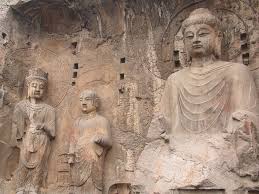
Luoyang, located in the western part of Henan Province, is one of China’s oldest cities and a significant cultural and historical center. Often referred to as the “Cradle of Chinese Civilization,” Luoyang served as the capital for 13 dynasties over a span of more than 1,500 years. This ancient city played a pivotal role in the development of Chinese culture, politics, and religion. A historical tour of Luoyang offers a deep dive into the origins of Chinese civilization and its enduring legacy.
Key Sites
- Longmen Grottoes
- Description: The Longmen Grottoes, a UNESCO World Heritage Site, are a series of caves and rock carvings along the cliffs of the Yi River. These grottoes, which date back to the Northern Wei Dynasty (386-534 AD) and were developed over subsequent dynasties, house thousands of Buddhist statues, inscriptions, and steles.
- Highlights: The site features over 100,000 Buddha statues, ranging from tiny carvings to monumental figures. The Fengxian Temple and the statue of Vairocana Buddha are particularly notable.
- Activities: Visitors can explore the caves, marvel at the intricate carvings, and learn about the history of Buddhism in China through guided tours.
- White Horse Temple
- Description: Established in 68 AD, the White Horse Temple is considered the first Buddhist temple in China. It marks the introduction of Buddhism to China from India and has been a significant center for Buddhist teaching and practice.
- Highlights: The temple complex includes ancient halls, pagodas, and statues, blending Chinese architectural styles with Buddhist elements.
- Activities: Visitors can tour the temple grounds, participate in meditation sessions, and observe religious ceremonies. The temple also features a beautiful garden and a replica of the original temple in India.
- Shaolin Temple
- Description: Situated at the foot of the Songshan Mountain, the Shaolin Temple is renowned as the birthplace of Chan (Zen) Buddhism and Shaolin Kung Fu. Founded in the late 5th century, it has been a center of martial arts training and spiritual practice for centuries.
- Highlights: Key attractions include the Hall of Heavenly Kings, the Pagoda Forest, and the Dharma Cave. The temple’s martial arts performances are world-famous.
- Activities: Visitors can watch daily Kung Fu demonstrations, participate in short martial arts training sessions, and explore the temple’s historical and religious sites.
Activities
- Historical Tours: Engaging in guided tours of the Longmen Grottoes, White Horse Temple, and Shaolin Temple provides in-depth historical context and fascinating insights into Luoyang’s cultural heritage.
- Cultural Performances: Watching traditional Chinese performances, such as Kung Fu shows at the Shaolin Temple, offers a dynamic and entertaining way to experience Luoyang’s cultural legacy.
- Temple Visits: Exploring the numerous temples and religious sites in and around Luoyang helps visitors understand the profound influence of Buddhism and other religions on Chinese culture and history.
Conclusion
Luoyang, the cradle of Chinese civilization, is a must-visit destination for those interested in China’s ancient history and cultural heritage. The breathtaking Longmen Grottoes, the historically significant White Horse Temple, and the legendary Shaolin Temple collectively offer a comprehensive glimpse into the spiritual, artistic, and martial traditions that have shaped China. Each site reflects the city’s role as a center of cultural and religious exchange, making Luoyang a key destination for understanding the foundations of Chinese civilization. Through historical tours, cultural activities, and immersive experiences, visitors can connect with the rich legacy of Luoyang and gain a deeper appreciation for its pivotal place in China’s history.
Nanjing – The Former Capital
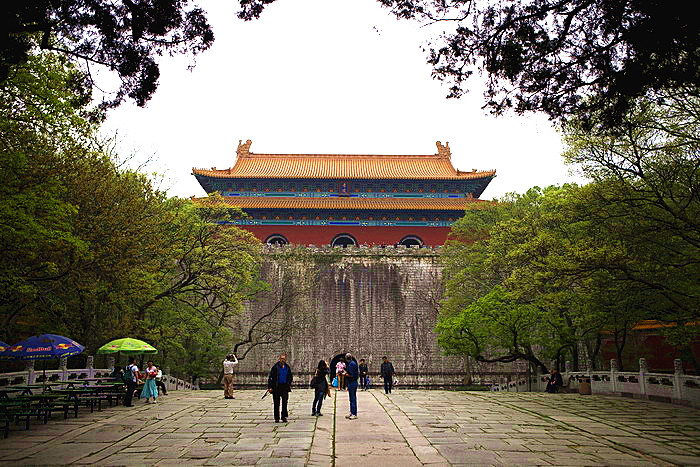
Nanjing, known as “Ningjing” or “Jinling” in ancient times, holds a prominent place in Chinese history as one of its former capitals and a cultural hub dating back thousands of years. Situated in the lower Yangtze River basin in Jiangsu Province, Nanjing has witnessed the rise and fall of dynasties, the forging of empires, and significant historical events that have shaped China’s identity. A historical tour of Nanjing offers a compelling narrative of imperial splendor, wartime struggles, and cultural richness.
Key Sites
- Sun Yat-sen Mausoleum
- Description: The Sun Yat-sen Mausoleum, situated in the scenic Purple Mountain area, is a memorial to Dr. Sun Yat-sen, the founding father of the Republic of China. Designed in a blend of traditional Chinese and modern architectural styles, the mausoleum is a symbol of China’s transition from imperial rule to republican governance.
- Highlights: The grand staircase, the Sacrificial Hall, and the crypt containing Dr. Sun Yat-sen’s tomb are key features of the mausoleum.
- Activities: Visitors can climb the stairs to the mausoleum, explore the surrounding park, and learn about Dr. Sun Yat-sen’s contributions to modern China through guided tours.
- Nanjing Massacre Memorial Hall
- Description: The Nanjing Massacre Memorial Hall commemorates the victims of the Nanjing Massacre (1937-1938) during World War II, when Nanjing, then known as Nanking, suffered horrific atrocities at the hands of Japanese forces. The memorial serves as a somber reminder of the city’s wartime experiences and a call for peace and remembrance.
- Highlights: Exhibits, artifacts, and historical documents vividly depict the tragic events of the massacre and honor the memory of the victims.
- Activities: Visitors can tour the memorial hall, attend educational programs, and reflect on the significance of historical remembrance.
- Confucius Temple
- Description: The Confucius Temple, also known as Fuzimiao, is a cultural and educational complex dedicated to the revered Chinese philosopher Confucius. Built during the Song Dynasty and reconstructed over the centuries, the temple is a center for Confucian worship, scholarship, and traditional arts.
- Highlights: The temple’s ornate architecture, serene courtyards, and statues of Confucius and his disciples create a contemplative atmosphere.
- Activities: Visitors can explore the temple grounds, participate in cultural activities such as calligraphy and traditional music performances, and gain insights into Confucian philosophy.
Activities
- Historical Tours: Guided tours of key historical sites in Nanjing provide context, historical narratives, and cultural insights, enriching visitors’ understanding of the city’s past.
- Memorial Visits: Paying respects at memorials like the Nanjing Massacre Memorial Hall fosters reflection on wartime tragedies and promotes dialogue on historical reconciliation.
- Cultural Experiences: Engaging in traditional activities at cultural sites, such as Confucius Temple, offers a hands-on appreciation of Nanjing’s cultural heritage and philosophical traditions.
Conclusion
Nanjing, the former capital, stands as a testament to China’s historical resilience, cultural vibrancy, and commitment to remembrance. The Sun Yat-sen Mausoleum, Nanjing Massacre Memorial Hall, and Confucius Temple represent different facets of the city’s legacy, from revolutionary movements and wartime tribulations to philosophical contemplation and educational pursuits. A historical tour of Nanjing invites visitors to explore the complexities of China’s past, engage with its cultural heritage, and honor the enduring spirit of resilience and renewal. Through meaningful experiences at historical sites, memorial halls, and cultural landmarks, travelers can gain profound insights into Nanjing’s role in shaping China’s narrative and contributing to its evolving identity.
Suzhou – The Venice of the East
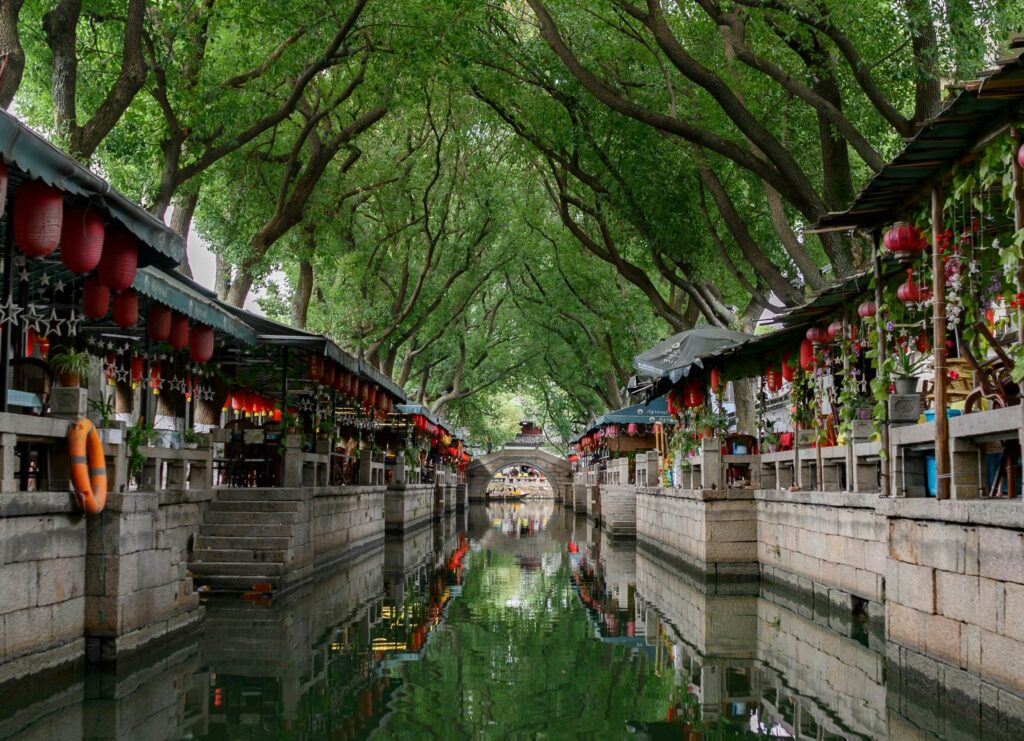
Suzhou, often referred to as the “Venice of the East,” is a city steeped in history, culture, and natural beauty. Located in Jiangsu Province, along the Grand Canal and the shores of Lake Tai, Suzhou is renowned for its classical gardens, traditional water towns, silk production, and rich cultural heritage. A historical tour of Suzhou offers a captivating journey through time, exploring its ancient gardens, canal networks, and unique cultural traditions.
Key Sites
- Classical Gardens of Suzhou
- Description: Suzhou is famous for its classical Chinese gardens, which are masterpieces of landscape design, architecture, and horticulture. These gardens, dating back to the 11th century, reflect the harmony between nature and human creativity.
- Highlights: Gardens like the Humble Administrator’s Garden, the Lingering Garden, and the Master of the Nets Garden showcase elements such as pavilions, rockeries, ponds, and intricate plantings.
- Activities: Visitors can wander through the gardens, admire the seasonal blooms, attend cultural performances, and learn about garden design principles.
- Grand Canal
- Description: The Grand Canal, a UNESCO World Heritage Site, is an ancient waterway that connects Beijing in the north to Hangzhou in the south, passing through Suzhou. Dating back over 2,500 years, the canal played a crucial role in trade, transportation, and cultural exchange in imperial China.
- Highlights: Scenic canal boat rides offer views of historic buildings, stone bridges, and traditional waterfront residences known as “water towns.”
- Activities: Exploring the canal by boat, visiting canal-side markets, and observing daily life along the waterways provide insights into Suzhou’s maritime history.
- Tiger Hill
- Description: Tiger Hill, also known as Huqiu, is a historic hill and park in Suzhou, steeped in legend and folklore. It is home to various ancient structures, including the Yunyan Pagoda (leaning pagoda) and the Sword-Testing Stone.
- Highlights: The Yunyan Pagoda, leaning at an angle similar to the Leaning Tower of Pisa, is a symbol of Suzhou. The Sword-Testing Stone is associated with the legendary swordsman Fan Li.
- Activities: Climbing Tiger Hill to admire the pagoda, exploring the gardens and pavilions, and learning about the hill’s myths and history offer a unique perspective on Suzhou’s heritage.
Activities
- Garden Tours: Exploring Suzhou’s classical gardens, participating in guided tours, and attending cultural events like traditional tea ceremonies and music performances enhance the appreciation of Suzhou’s garden artistry.
- Canal Cruises: Taking leisurely boat rides along the Grand Canal and visiting nearby water towns like Zhouzhuang or Tongli provides a scenic and immersive experience of Suzhou’s water-based culture.
- Cultural Workshops: Engaging in hands-on activities such as silk weaving, calligraphy, and traditional painting workshops offers insights into Suzhou’s artistic traditions and craftsmanship.
Conclusion
Suzhou, the Venice of the East, is a treasure trove of historical and cultural wonders that captivate visitors with its timeless beauty and enduring charm. From the enchanting classical gardens and tranquil canal networks to the legendary Tiger Hill and its ancient pagoda, Suzhou offers a glimpse into China’s artistic, architectural, and maritime heritage. A historical tour of Suzhou not only delves into the city’s past but also celebrates its vibrant present, where age-old traditions blend seamlessly with modern life. Through immersive experiences, cultural interactions, and exploration of iconic landmarks, travelers can embark on a memorable journey through Suzhou’s rich history and cultural legacy, discovering the essence of the Venice of the East along the way.
Hangzhou – Heaven on Earth
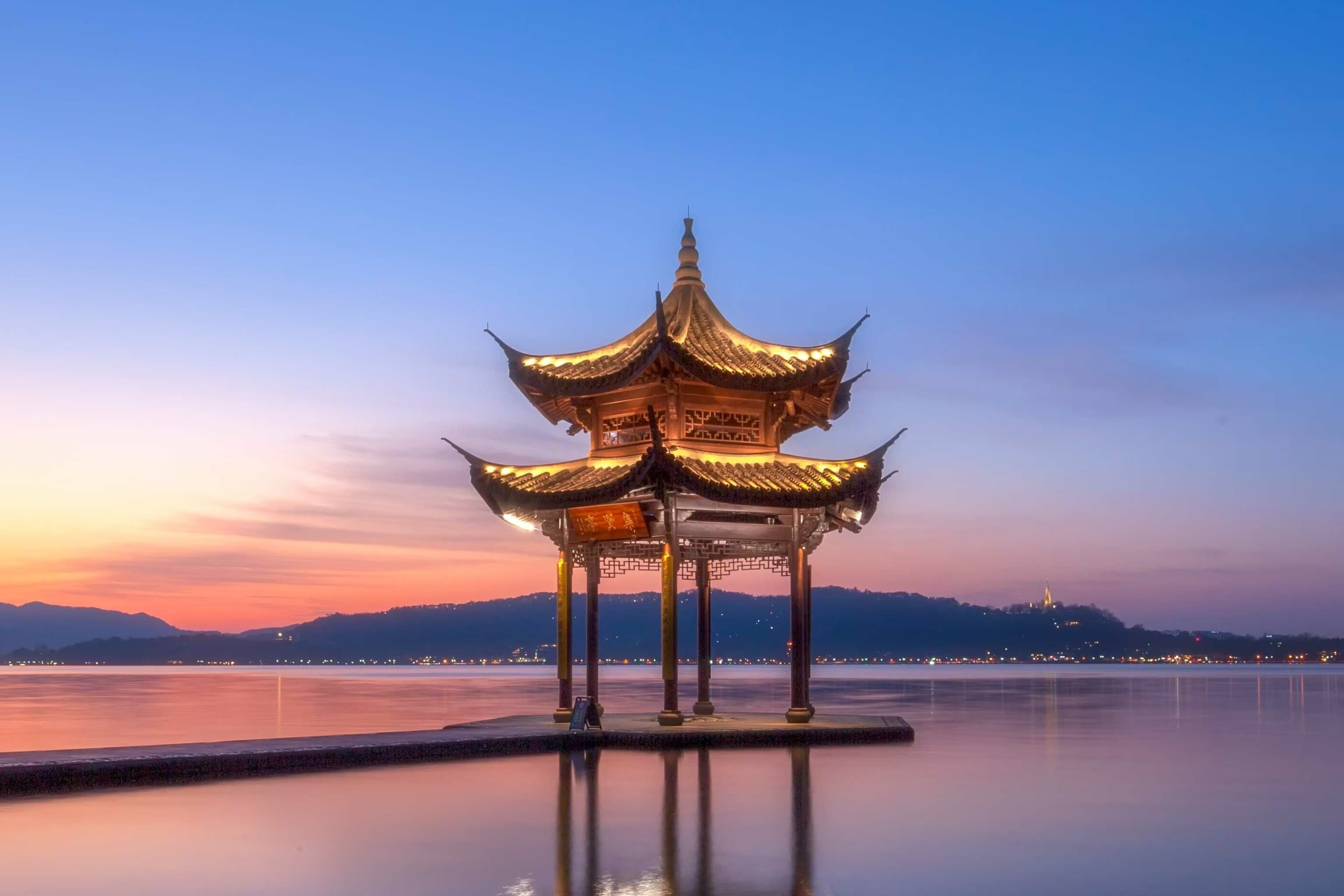
Hangzhou, nestled in the heart of Zhejiang Province, is renowned for its natural beauty, cultural heritage, and serene ambiance. Often described as “Heaven on Earth” by poets and scholars throughout history, Hangzhou captivates visitors with its picturesque West Lake, ancient temples, tea plantations, and rich artistic traditions. A historical tour of Hangzhou offers a delightful blend of scenic landscapes, historical sites, and cultural experiences.
Key Sites
- West Lake
- Description: West Lake is the centerpiece of Hangzhou’s natural beauty and cultural significance. Surrounded by lush gardens, pagodas, and historic sites, the lake has inspired poets, artists, and scholars for centuries.
- Highlights: Key attractions around West Lake include the Leifeng Pagoda, Lingyin Temple, Six Harmonies Pagoda, and the scenic Su Causeway.
- Activities: Boating on the lake, strolling along the shores, visiting lakeside temples, and watching the sunset are popular activities.
- Lingyin Temple
- Description: Lingyin Temple, also known as the Temple of the Soul’s Retreat, is one of the most revered Buddhist temples in China. Founded over 1,600 years ago during the Eastern Jin Dynasty, the temple complex is nestled in the picturesque Feilai Peak area.
- Highlights: The Grand Hall of the Great Sage, the Hall of Heavenly Kings, and the Thousand-Buddha Hall showcase exquisite Buddhist art and architecture.
- Activities: Exploring the temple grounds, participating in Buddhist rituals, and admiring ancient stone carvings and statues offer a spiritual and cultural experience.
- Six Harmonies Pagoda
- Description: The Six Harmonies Pagoda, located on the Qiantang River, is a majestic wooden pagoda dating back to the Song Dynasty. Its name symbolizes harmony between the six elements of heaven, earth, north, south, east, and west.
- Highlights: Climbing to the top of the pagoda provides panoramic views of the river, surrounding mountains, and the Qiantang tidal bore.
- Activities: Visitors can learn about the pagoda’s history, enjoy scenic views, and witness the impressive tidal phenomenon during certain times of the year.
Activities
- Boat Tours: Exploring West Lake by boat, especially during sunrise or sunset, offers a tranquil and scenic experience, with views of pagodas, gardens, and ancient bridges.
- Tea Culture: Visiting Longjing (Dragon Well) Tea Plantations, participating in tea ceremonies, and learning about Hangzhou’s tea culture and production techniques are enlightening experiences.
- Cultural Performances: Watching traditional performances like Yue Opera, silk embroidery demonstrations, and Chinese painting exhibitions showcases Hangzhou’s artistic heritage.
Conclusion
Hangzhou, hailed as Heaven on Earth, is a captivating destination that harmonizes natural beauty, cultural richness, and historical allure. The ethereal beauty of West Lake, the spiritual ambiance of Lingyin Temple, and the architectural splendor of Six Harmonies Pagoda embody Hangzhou’s poetic charm and timeless elegance. A historical tour of Hangzhou invites travelers to immerse themselves in its scenic landscapes, ancient traditions, and artistic legacies, creating unforgettable memories and a deeper appreciation for this enchanting city. Through boat rides, temple visits, tea experiences, and cultural encounters, visitors can discover the essence of Heaven on Earth and unravel the enchanting tapestry of Hangzhou’s past and present.
Chengdu – Land of the Pandas
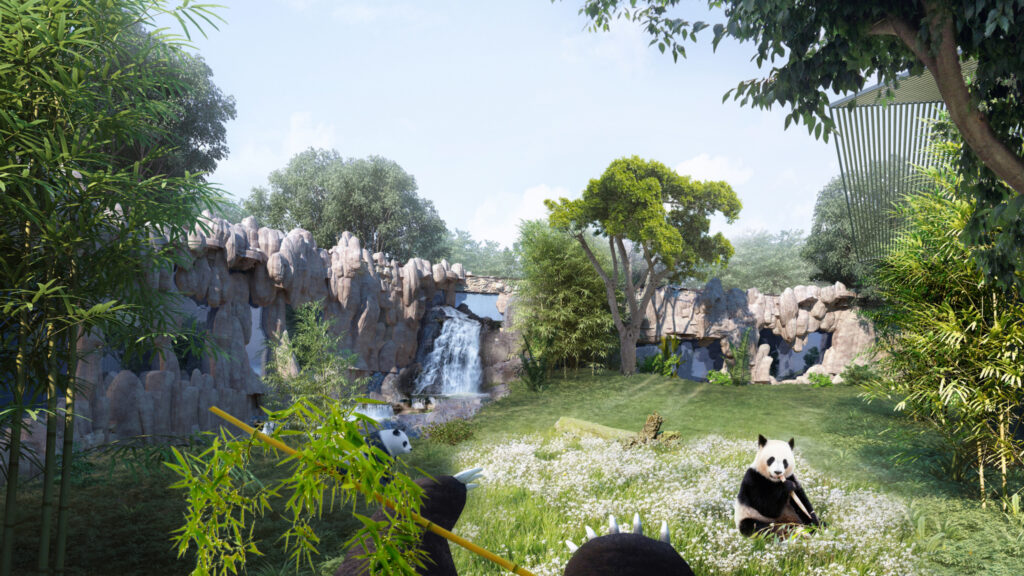
Chengdu, the capital of Sichuan Province in southwestern China, is renowned as the “Land of the Pandas” due to its close association with the beloved giant panda. Beyond its cuddly ambassadors, Chengdu boasts a rich history, vibrant culture, spicy cuisine, and scenic landscapes. A visit to Chengdu offers a unique blend of wildlife conservation, historical exploration, and culinary delights.
Key Sites
- Chengdu Research Base of Giant Panda Breeding
- Description: The Chengdu Panda Base is a leading center for the conservation and breeding of giant pandas. It provides a natural habitat for pandas to thrive and offers visitors a chance to observe these iconic animals up close.
- Highlights: Giant pandas of various ages, red pandas, and educational exhibits about panda conservation efforts.
- Activities: Watching pandas play, feeding sessions, learning about panda behavior, and contributing to conservation efforts through donations or volunteering.
- Jinli Ancient Street
- Description: Jinli Ancient Street is a bustling pedestrian street in Chengdu’s historic center, known for its traditional architecture, lively atmosphere, and diverse street food.
- Highlights: Ancient-style buildings, tea houses, handicraft shops, local snacks such as Sichuan noodles, skewers, and spicy delicacies.
- Activities: Exploring the street, trying local snacks, shopping for souvenirs, enjoying traditional performances like Sichuan opera or shadow puppetry.
- Wuhou Shrine and Jinsha Site Museum
- Description: Wuhou Shrine, dedicated to Zhuge Liang of the Three Kingdoms period, and Jinsha Site Museum, showcasing ancient artifacts from the Jinsha archaeological site, offer insights into Chengdu’s historical and cultural heritage.
- Highlights: Historical relics, ancient ruins, traditional architecture, gardens, and cultural exhibitions.
- Activities: Exploring the shrine’s gardens, learning about Three Kingdoms history, admiring ancient artifacts at the museum, and attending cultural events.
Activities
- Panda Volunteer Programs: Participating in panda volunteer programs at the Chengdu Panda Base allows for a hands-on experience in caring for pandas and supporting conservation efforts.
- Sichuan Opera Performances: Watching a Sichuan opera performance, known for face-changing acts, fire-spitting stunts, and traditional music, provides a cultural immersion into Chengdu’s theatrical heritage.
- Sichuan Cuisine Tasting: Sampling Sichuan cuisine, famous for its spicy and flavorful dishes like mapo tofu, hot pot, and kung pao chicken, is a culinary adventure not to be missed.
Conclusion
Chengdu, the Land of the Pandas, offers a delightful fusion of wildlife encounters, cultural exploration, and gastronomic delights. The Chengdu Panda Base provides a window into the world of giant pandas and conservation efforts, while Jinli Ancient Street and historical sites like Wuhou Shrine and Jinsha Museum showcase Chengdu’s rich history and vibrant culture. Exploring Chengdu’s culinary scene, enjoying Sichuan opera performances, and immersing oneself in the city’s lively atmosphere create unforgettable memories in this charming city. Whether cuddling pandas, savoring spicy delicacies, or delving into ancient history, Chengdu offers a diverse and enchanting experience for travelers seeking a unique blend of nature, culture, and adventure.
Lijiang – Ancient Town
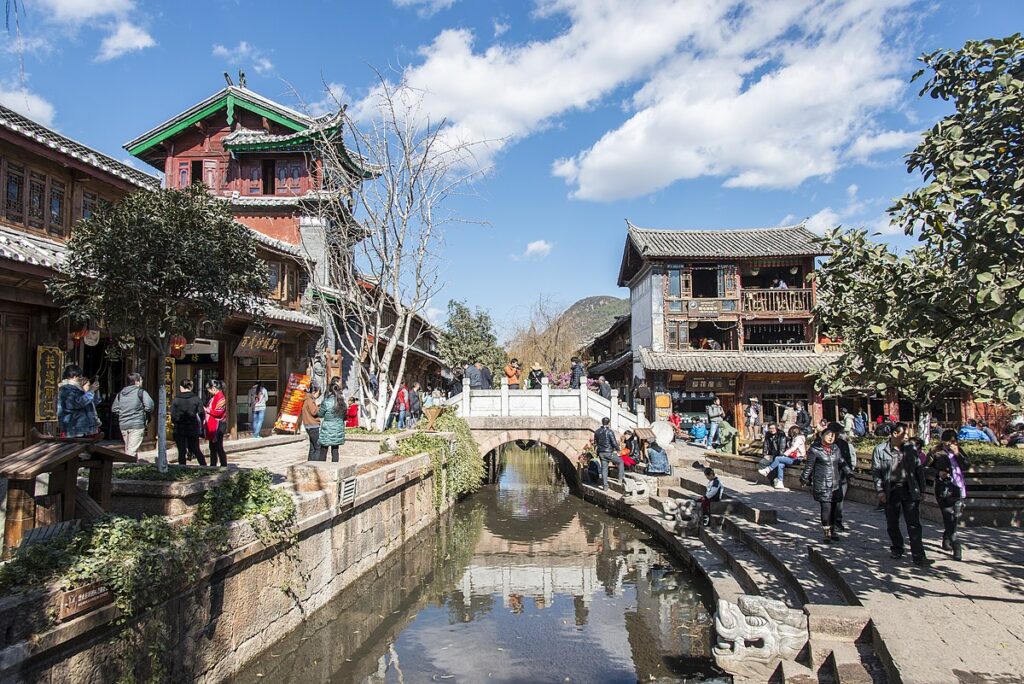
Lijiang, located in Yunnan Province in southwestern China, is a mesmerizing ancient town steeped in history, culture, and natural beauty. Designated as a UNESCO World Heritage Site, Lijiang’s Old Town transports visitors back in time with its cobblestone streets, traditional Naxi architecture, and rich heritage. A visit to Lijiang’s Ancient Town offers a glimpse into China’s past, ethnic diversity, and artistic traditions.
Key Sites
- Lijiang Old Town
- Description: Lijiang’s Old Town is a maze of narrow lanes, canals, and historic buildings dating back over 800 years. It was an important stop on the ancient Tea Horse Road and served as a cultural melting pot for various ethnic groups.
- Highlights: Ancient wooden houses, stone bridges, waterwheels, the iconic Mu Palace, and the vibrant market square.
- Activities: Strolling through the old streets, admiring traditional Naxi architecture, shopping for handicrafts, and tasting local delicacies.
- Black Dragon Pool
- Description: The Black Dragon Pool Park, located at the foot of Elephant Hill, is renowned for its picturesque scenery and historic pavilions. The clear waters of the pool reflect the Jade Dragon Snow Mountain, creating a stunning backdrop.
- Highlights: The Moon-Embracing Pavilion, Five Phoenix Tower, and lush gardens with ancient trees and blooming flowers.
- Activities: Enjoying serene walks, taking photos of the mountain reflections, and learning about the park’s legends and significance.
- Baisha Village and Murals
- Description: Baisha Village, a short distance from Lijiang, is known for its ancient Naxi culture and exquisite murals dating back to the Ming Dynasty. The Baisha Murals depict religious and historical scenes, showcasing the region’s artistic heritage.
- Highlights: Intricate murals in temples like Dabaoji Palace, Liuli Temple, and the Naxi Dongba Cultural Research Institute.
- Activities: Exploring the village, admiring the murals’ craftsmanship, interacting with locals, and learning about Naxi culture and Dongba religion.
Activities
- Naxi Culture Experiences: Engaging in cultural activities such as Naxi music performances, Dongba painting workshops, and traditional tea ceremonies offers insights into Lijiang’s unique heritage.
- Hiking and Nature Exploration: Trekking in the nearby scenic areas, such as Jade Dragon Snow Mountain or Tiger Leaping Gorge, provides breathtaking views and outdoor adventures.
- Local Cuisine Tasting: Sampling Naxi cuisine, including specialties like Yak meat dishes, Yunnan noodles, and butter tea, is a culinary journey through Lijiang’s flavors.
Conclusion
Lijiang’s Ancient Town is a captivating destination that encapsulates the essence of ancient China, ethnic diversity, and natural beauty. From the labyrinthine streets of the Old Town to the tranquil waters of Black Dragon Pool and the cultural richness of Baisha Village, Lijiang offers a tapestry of experiences for travelers. Exploring centuries-old architecture, admiring vibrant murals, immersing oneself in Naxi traditions, and enjoying the region’s scenic landscapes create unforgettable memories in this enchanting corner of Yunnan Province. Whether seeking historical insights, cultural encounters, or outdoor adventures, Lijiang’s Ancient Town promises a journey of discovery and wonder in a timeless setting.
Shangri-La – Tibetan Influence

Shangri-La, officially known as Zhongdian, is a mystical town nestled in the mountains of northwestern Yunnan Province, China. Renowned for its Tibetan cultural heritage, breathtaking landscapes, and spiritual ambiance, Shangri-La evokes a sense of serenity and wonder. The town’s Tibetan influence, seen in its architecture, customs, and way of life, makes it a unique and captivating destination for travelers seeking a glimpse into Tibetan culture.
Key Sites
- Songzanlin Monastery (Ganden Sumtseling Monastery)
- Description: Songzanlin Monastery, often referred to as the “Little Potala Palace,” is a prominent Tibetan Buddhist monastery located on a hillside overlooking Shangri-La. It is one of the largest monasteries in Yunnan and a significant center of Tibetan religious and cultural practices.
- Highlights: Intricate Tibetan architecture, colorful prayer flags, prayer halls adorned with Buddhist art, and scenic views of the surrounding mountains.
- Activities: Exploring the monastery complex, observing monks in prayer, attending religious ceremonies, and learning about Tibetan Buddhism and culture.
- Old Town Shangri-La
- Description: The Old Town of Shangri-La retains its traditional Tibetan character with whitewashed buildings, prayer wheels, and bustling market streets. It serves as a hub for local Tibetan artisans, traders, and cultural activities.
- Highlights: Tibetan-style houses, the Dukezong Ancient Town Square, traditional Tibetan clothing shops, handicraft markets, and lively cultural performances.
- Activities: Walking tours of the Old Town, shopping for Tibetan souvenirs like thangka paintings and yak wool products, tasting Tibetan cuisine, and experiencing local festivals and dances.
- Napahai Lake and Grasslands
- Description: Napahai Lake, situated on the outskirts of Shangri-La, is a scenic wetland area surrounded by rolling grasslands and snow-capped mountains. It is an important habitat for migratory birds and a tranquil spot for nature lovers.
- Highlights: Birdwatching, horse riding across the grasslands, panoramic views of the Himalayas, and experiencing the nomadic lifestyle of local Tibetan herders.
- Activities: Birdwatching tours, horseback riding expeditions, photography excursions, and cultural exchanges with Tibetan nomads.
Activities
- Tibetan Cultural Experiences: Participating in Tibetan cultural workshops, such as thangka painting, Tibetan calligraphy, and butter sculpture making, offers insights into traditional arts and crafts.
- Trekking and Nature Exploration: Embarking on trekking adventures in nearby areas like Tiger Leaping Gorge or Meili Snow Mountain provides scenic vistas, alpine landscapes, and encounters with local flora and fauna.
- Tibetan Cuisine Tasting: Sampling Tibetan delicacies like yak meat dishes, momos (dumplings), butter tea, and barley-based foods allows for a culinary exploration of Tibetan flavors.
Conclusion
Shangri-La, with its strong Tibetan influence, offers a transformative travel experience immersed in Tibetan culture, spirituality, and natural beauty. From the ancient serenity of Songzanlin Monastery to the vibrant markets of Old Town Shangri-La and the pristine landscapes of Napahai Lake, every corner of this town reflects the rich tapestry of Tibetan traditions and heritage. Engaging in cultural activities, exploring sacred sites, interacting with local Tibetans, and savoring Tibetan cuisine create unforgettable memories and a deeper understanding of Tibetan culture in the heart of Yunnan Province. Shangri-La truly embodies the essence of a mystical Himalayan sanctuary, inviting travelers to discover a world of tranquility, cultural diversity, and spiritual exploration.
Travel Tips
Travel Tips for a Memorable Journey
- Plan and Research: Research your destination thoroughly before your trip. Understand the local culture, customs, weather, and important landmarks to visit. Planning ahead ensures a smoother and more enjoyable experience.
- Pack Smartly: Pack light, especially if you plan to move around frequently. Bring versatile clothing suitable for the local climate and activities. Don’t forget essentials like travel documents, medications, chargers, and adaptors.
- Stay Connected: Keep important contacts handy, including emergency numbers, hotel information, and local guides or tour operators. Stay connected with family or friends back home using reliable communication methods.
- Stay Safe: Prioritize your safety while traveling. Be aware of your surroundings, avoid risky areas, and follow local laws and regulations. Keep your valuables secure and use lockers or safes provided by accommodations.
- Respect Local Culture: Respect the local customs, traditions, and etiquette of the places you visit. Learn a few basic phrases in the local language to communicate respectfully with locals. Dress modestly in culturally sensitive areas.
- Try Local Cuisine: Explore the local cuisine and try traditional dishes for an authentic culinary experience. Be adventurous but mindful of food hygiene practices, especially when eating street food.
- Stay Healthy: Maintain good hygiene practices, stay hydrated, and get enough rest during your travels. Carry necessary medications, insect repellents, and sunscreen. Be cautious with tap water and opt for bottled or purified water.
- Be Flexible: Embrace spontaneity and be flexible with your itinerary. Unexpected events or changes in plans are part of the adventure. Allow yourself to discover hidden gems and unique experiences off the beaten path.
- Engage with Locals: Interact with locals to learn more about their culture, traditions, and way of life. Engage in cultural activities, attend festivals or events, and support local businesses and artisans.
- Capture Memories: Take plenty of photos and videos to capture your travel memories. Keep a travel journal or blog to document your experiences, thoughts, and reflections.
Remember to enjoy every moment of your journey, embrace new experiences, and cherish the memories you create along the way. Safe travels!
Conclusion
Exploring the historical wonders of China is a journey through time, culture, and human ingenuity. From the majestic Great Wall to the ancient capital of Xi’an, the cradle of Chinese civilization in Luoyang, the former capitals of Beijing and Nanjing, and the enchanting ancient towns of Lijiang and Shangri-La, each destination offers a unique glimpse into China’s rich and diverse heritage.
As you embark on historical tours in China, immerse yourself in the stories of emperors and dynasties, marvel at architectural marvels that have withstood centuries, and discover the traditions and customs that have shaped Chinese society. Engage with local guides, visit museums and cultural sites, and embrace the vibrant tapestry of Chinese history.
Whether you’re drawn to the grandeur of imperial palaces, the tranquility of ancient gardens, or the spiritual sanctuaries of temples and monasteries, China’s historical tours promise an enriching and unforgettable experience. As you bid farewell to these historical treasures, carry with you the knowledge, memories, and newfound appreciation for the enduring legacy of one of the world’s oldest and most fascinating civilizations.
Read more Historical Tours in Japan
